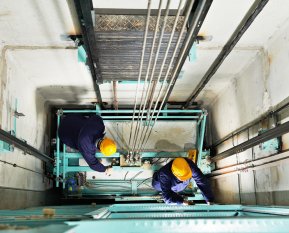-
Maintaining Your Residential Elevator
It can be incredibly inconvenient when your residential elevator near Salt Lake City breaks down and requires repair. To help prevent this problem from occurring, regular elevator maintenance is essential . Focusing on maintaining rather than repairing your residential elevator can save you from a significant amount of frustration as well as from costly repair bills.
Opting to participate in an elevator maintenance plan can help ensure that your elevator runs safely, smoothly, and properly. These plans can benefit you by providing regularly scheduled checkups for the equipment, clear communication about the state and maintenance needs of your elevator, and the use of quality, on-hand repair parts.
Elevator maintenance plans can give you peace of mind with the knowledge that your elevator receives regular repairs and new parts as needed, allowing you to worry less about the safety and function of the equipment. Leaving your elevator maintenance in the hands of a skilled and experienced technician can help keep it running correctly and continuously.
-
Understanding How Elevators Work
 When you walk into a building that has multiple floors inside of it, the first thing you probably do is look around for an elevator . Elevators are used to carry people from one floor to another within a building, and they make it easy to live or work in a building that has many floors. Before you install an elevator in Salt Lake City, though, it’s important to understand how elevators work. Here are the two main types of elevators along with a brief explanation on how they are able to transport people from floor to floor inside of buildings.
When you walk into a building that has multiple floors inside of it, the first thing you probably do is look around for an elevator . Elevators are used to carry people from one floor to another within a building, and they make it easy to live or work in a building that has many floors. Before you install an elevator in Salt Lake City, though, it’s important to understand how elevators work. Here are the two main types of elevators along with a brief explanation on how they are able to transport people from floor to floor inside of buildings.Hydraulic Elevators
A hydraulic elevator contains a cylinder, a piston, a fluid reservoir, a rotary pump, a valve, and hydraulic fluid, and it relies on basic hydraulic principles to move up and down. When you instruct a hydraulic elevator to take you to a higher floor inside of a building, the pump will send fluid into the cylinder and close a valve that will pressurize the fluid and push the piston up. This will propel the elevator upwards and, once it reaches your desired floor, the pump will shut off and the elevator will eventually stop moving. To go down, the opposite action is taken with the valve opening and releasing fluid back into the reservoir as the elevator moves back down towards the ground level.
Roped Elevators
A roped elevator contains steel ropes, a sheave that is used to hoist the ropes, an electric motor, a counterweight, guide rails, and a gear train. This type of elevator is similar to a seesaw in that it works to balance the weight of an elevator car in addition to the weight inside of the car with the counterweight. The motor is used to move the elevator up or down based on where you want it to go.
Safety Systems
Regardless of what type of high quality elevator you install in a building, it should come equipped with reliable safety systems that will prevent an elevator car from freefalling. Safety systems need to be maintained regularly to ensure they are working properly.
-
Spotlight on Elevator History
The first elevators in the United States were only put into service about 200 years ago, but since then, elevators have evolved quite a bit. Watch this video to hear about some of the earliest elevators serving Salt Lake City and to find out about how elevators have changed over the years.
Once upon a time, elevators were only used to transport supplies up and down inside of buildings, and they weren’t considered safe enough for people to ride. However, that eventually changed and before long, operators were working inside of elevators and helping people get to floors inside of tall buildings. Today, it’s common to install an elevator in a hotel, commercial property, apartment complex, or any building with multiple floors. By selecting the right elevator for your property, you can make it easier for people to navigate their way around inside of your building.
RECENT POSTS
categories
- Uncategorized
- Home Elevator
- Carson Elevator
- Elevator Safety
- Accessibility Elevators
- Elevator Maintenance
- Hydraulic Elevators
- Dumbwaiter
- Dumbwaiter Installation
- residential elevator
- Roped Elevators
- commercial elevators
- Stair Lift
- Corporate Elevator
- Elevator
- Elevator Etiquette
- ADA Compliance
- new elevators
- luxury elevators
- Elevator Inspection
- Package Lifts
- Trus-T-Lifts
- Elevator Pulley Systems
Archives
2019
2018
2017
- December (3)
- November (4)
- October (5)
- September (2)
- August (3)
- July (5)
- June (1)
- May (4)
- April (1)
- March (4)
- February (1)
- January (3)
2016
- December (4)
- November (3)
- October (5)
- September (3)
- August (3)
- July (4)
- June (5)
- May (4)
- April (4)
- March (4)
- February (4)
- January (4)
